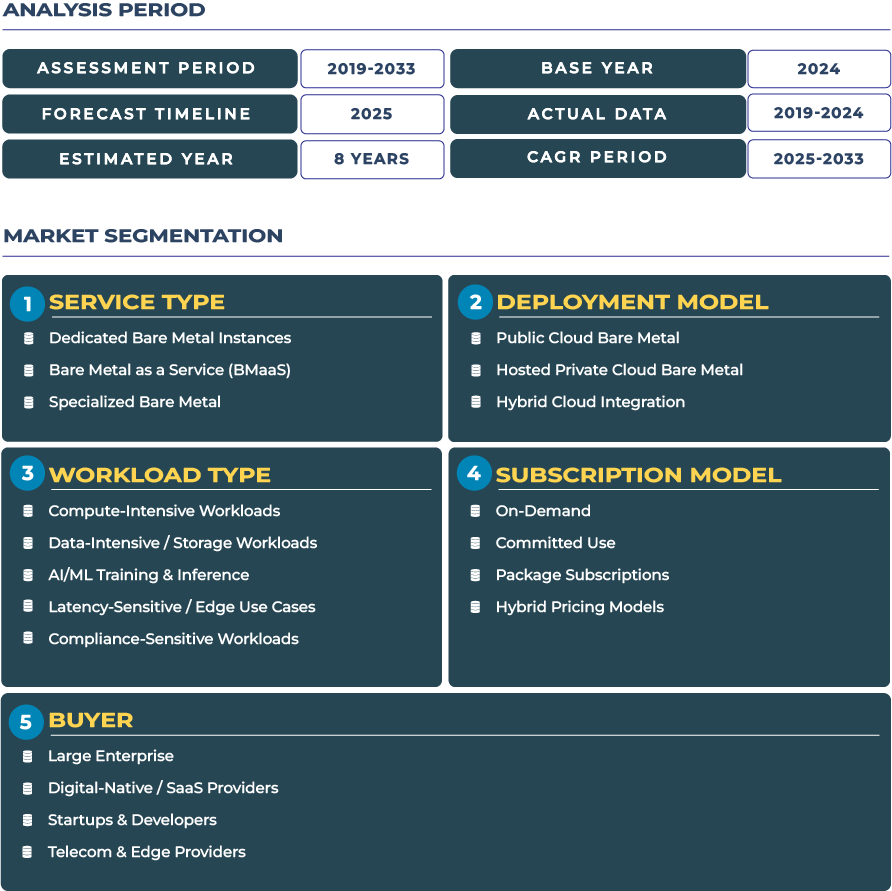Taiwan Cloud Bare Metal Market Outlook: OEM and AI/ML-Accelerated Bare Metal Leading the Compute Vanguard
Taiwan occupies a rare strategic intersection of semiconductor prowess, cloud infrastructure ambition, and AI/ML workload growth. In this environment, Taiwan cloud bare metal ecosystem is gravitating toward OEM-driven, AI/ML-accelerated bare metal solutions. Hardware OEMs and server manufacturers in Taiwan (e.g. MiTAC, QCT) already interface with global hyperscalers, making Taiwan a natural ground for deploying custom server configurations, GPU/FPGA integration, and high-density racks. Enterprises and AI labs increasingly demand tailored compute stacks that combine raw performance, minimal virtualization overhead, and optimized cooling-use cases that bare metal uniquely supports. Within this framework, Taiwan is evolving from a compute consumer to a compute innovator, embedding bare metal into its AI and hardware symbiosis.
The Taiwan cloud bare metal market is forecast to grow from approximately USD 162.2 million in 2025 to USD 466.5 million in 2033, reflecting a CAGR of around 14.1 %. This projection is anchored in Taiwan robust data center expansion, aggressive AI commitments, and growing cloud localization pressures. As of 2024, Taiwan hosts 22 active data centers with major players such as Chunghwa Telecom, Chief Telecom, and global entrants like Vantage Data Centers and Google. The Taiwanese government has pledged USD 3 billion investments into AI data center infrastructure over the coming years. The arrival of the AWS Asia Pacific Region-with a projected multibillion-dollar investment-signals a tectonic shift in local compute capacity and demand. These developments, combined with Taiwan established semiconductor and server manufacturing ecosystem, will catalyze bare metal uptake for high-throughput, customizable, AI-ready workloads.
Drivers & Restraints: Forces Steering Taiwan Bare Metal Evolution
Driver: Custom Hardware Configurations & Sustained Heavy Workloads Demand
One of Taiwan distinctive drivers is the presence of world-class OEMs and server manufacturers-companies like https://www.mitac.com/en-global already integrate into global cloud supply chains. (MiTAC) This hardware foundation enables local providers and enterprises to request customized server, GPU, FPGA, and NIC combinations perfectly suited to AI/ML, high-performance analytics, and large-scale inference workloads. In contexts where sustained performance, temperature control, and rack density are critical, bare metal offers the ability to optimize at every layer from firmware to cooling. As industry and academia push heavy workloads-simulation, model training, data lakes-bare metal becomes less a niche and more a necessity within Taiwan compute roadmap.
Restraint: Firmware-level Security Risks, Persistence Attacks & Supply Chain Limits
On the flip side, bare metal infrastructure introduces unique risks-particularly at the firmware or BIOS layer. Security concerns such as persistent malware, firmware rootkits, or supply-chain contamination pose threats that tenants may perceive more acutely on bare metal than in managed virtualization. Overcoming these concerns demands strong attestation, firmware transparency, and trust anchors. Another restraint is supply chain pressure on advanced silicon (GPUs, accelerators) in global demand cycles. Taiwan own high demand for semiconductor hardware for export markets can strain local affordable supply for cloud compute needs. These constraints slow the roll-out pace of high-end bare metal nodes and push initial adoption into premium or research-tier segments rather than broad enterprise adoption.
Trends & Opportunities: What’s Emerging in Taiwan Bare Metal Ecosystem
Trend: AI/ML Workload Adoption & High-Speed Networking Integration
A clear trend is the increasing deployment of AI/ML workloads on bare metal in Taiwan-research institutions, chip design firms, and cloud service providers are embracing inference clusters, model training pods, and specialized acceleration nodes. These deployments demand high-bandwidth, low-latency networking, often at 100G/400G scales, tightly integrated with the hardware stack. Providers are adapting infrastructure to support RDMA, RoCE, NVMe over Fabrics, and custom GPU interconnects. This trend strengthens the Taiwan cloud bare metal landscape as not just raw compute, but intelligent, accelerated compute fabric.
Opportunity: GPU/FPGA-Accelerated Bare Metal & OEM Partnerships for Custom Configurations
One of the strongest opportunities lies in offering GPU/FPGA-accelerated bare metal solutions-dedicated clusters tuned for deep learning, inference, simulation, or edge AI. By offering modular accelerator attachments, firms can appeal to AI startups, enterprises, and labs seeking bare metal without the overhead of designing the full infrastructure. Another key opportunity is strategic partnerships between cloud providers and OEMs to deliver custom server stacks, co-branded offerings, or bare metal zones optimized for local silicon innovation. Such alliances enable differentiation in Taiwan compute market: infrastructure with local hardware pedigree, integrated support, and performance guarantees.
Competitive Landscape: Alliances, Local Providers & Infrastructure Strategies
Taiwan competitive ecosystem blends local operators, global cloud entrants, and hardware manufacturers. eASPNet, with over 20 years in cloud operations, is a leading local cloud and infrastructure platform in Taiwan. Infrastructure players such as Vantage Data Centers have launched advanced green campuses (e.g. TPE1 in Taipei, 16MW) aiming for sustainable, dense compute hubs. Meanwhile, hyperscalers are making direct investments: AWS has launched the Asia Pacific (Taipei) Region with over USD 5 billion in commitments. Google’s Changhua County data center further anchors compute in Taiwan. In hardware, firms like Wiwynn and Quanta Cloud Technology (QCT) are major suppliers of server and cloud infrastructure globally-and their local presence enhances alignment between compute demand and supply. Competitive differentiation in Taiwan bare metal domain will revolve around OEM integration, accelerator support, network density, transparency in firmware trust, service orchestration, sustainability, and reliable power design. Providers that can stitch together hardware, compute, and service layers will emerge as leaders in Taiwan cloud bare metal sector.







